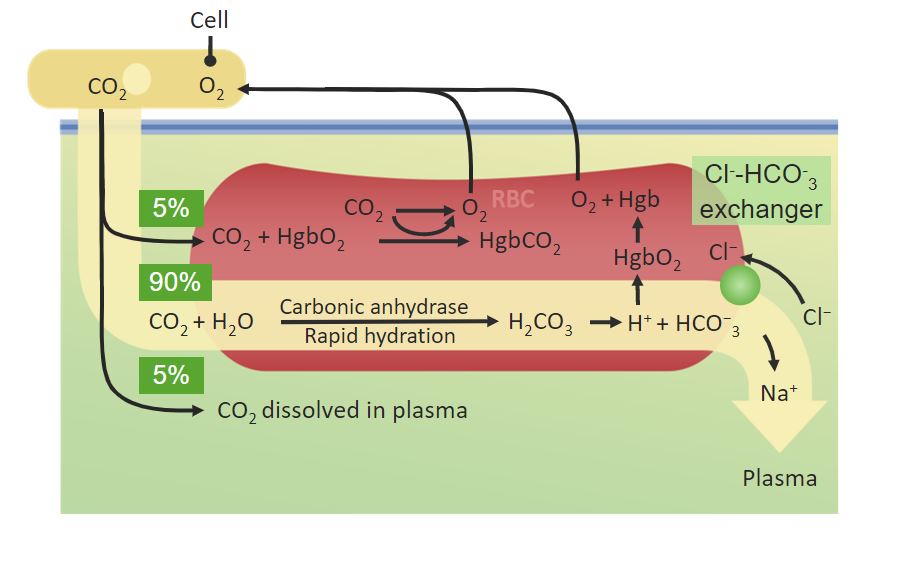Playlist
Show Playlist
Hide Playlist
Oxygen Transport – Gas Transport
-
Slides Gas Transport.pdf
-
Download Lecture Overview
00:02 In this lecture, we’re dealing with the transport of O2 and CO2. 00:07 Our learning goals will be to understand O2 transport and be able to differentiate between those modes of transport. 00:16 Also, you will be to identify the factors that affect oxygen hemoglobin dissociation. 00:23 Furthermore, after this lecture, you’ll be able to understand CO2 transport and be able to differentiate the modes of transport as well as identify factors that affect that transport. 00:35 So as we think about O2 transport, we really need to concentrate on what the partial pressure of oxygen is. 00:44 And so there are three partial pressures that we need to keep in mind. 00:48 PaO2, PaO2 and PVO2. 00:53 And the reason why I very much distinguished between capital A and small A O2, is it tells you where to locate it. 01:01 So PaO2 is the partial pressure of oxygen in the arterial circulation. 01:06 PAO2 is the partial pressure of oxygen in the alveoli. 01:11 PVO2 is the partial pressure of oxygen in the venous circulation. 01:16 And you need to remember what those are as we walk through O2 transport. 01:22 So to give you an idea of those numbers, the PaO2 is around 95. 01:27 The PAO2 is around 100, and the PVO2 is around 40 millimeters of mercury. 01:34 And so those are numbers you want to kind of keep in mind as we walk through this transport of oxygen. 01:43 Those numbers seem like they are going to be very important because these are the numbers that we measure from an arterial blood gas. 01:52 So if were to take an arterial sample and measure the amount of oxygen in it, those are the numbers that you get. 01:59 So this is a very important thing to help us distinguish between if someone has a hypoxemia, versus they have a normal O2 concentration. 02:07 Those are the partial pressures. 02:11 However, partial pressure only gives us one insight into how much O2 is being carried by the blood. 02:19 The other insight that we need to think about is how much is diffused in a gaseous form and that is really based upon the amount of O2 solubility. 02:30 Unfortunately, O2 is not very soluble. 02:33 So let’s go through a calculation to edify this. 02:37 Dissolved O2 is the partial pressure of O2 times the solubility of O2 at body temperature. 02:44 If we go through this calculation, it ends up that you have less than 1 milliliter of O2 per 100 mL of blood or per 1 deciliter of blood. 02:56 So just a very small amount. 02:59 If we look on the venous side, it’s even smaller 0.124. 03:04 So these are very, very, very small concentrations of oxygen in a dissolved form. 03:14 So having this amount of oxygen only in the dissolved form is unfortunately not compatible with life. 03:22 If you did not have someway to carry the oxygen, you would not be able to transport enough blood to cells to keep them alive via aerobic metabolism.
About the Lecture
The lecture Oxygen Transport – Gas Transport by Thad Wilson, PhD is from the course Respiratory Physiology.
Included Quiz Questions
Which are normal values for PAO2, PaO2, and PvO2 respectively?
- 100 mmHg, 95 mmHg, and 40 mmHg
- 95 mmHg, 100 mmHg, and 40 mmHg
- 40 mmHg, 95 mmHg, and 100 mmHg
- 95 mmHg, 55 mmHg, 200 mmHg
- 50 mmHg, 95 mmHg, 40 mmHg
Which of the following is the dissolved concentration of O2 in a normothermic patient, with a PaO2 of 90 mmHg?
- 0.28 mL of O2 per dL of blood
- 0.30 mL of O2 per dL of blood
- 0.12 mL of O2 per dL of blood
- 0.13 mL of O2 per dL of blood
- 0.32 mL of O2 per dL of blood
Customer reviews
5,0 of 5 stars
| 5 Stars |
|
1 |
| 4 Stars |
|
0 |
| 3 Stars |
|
0 |
| 2 Stars |
|
0 |
| 1 Star |
|
0 |
like it very much thanks Thad you are very good





